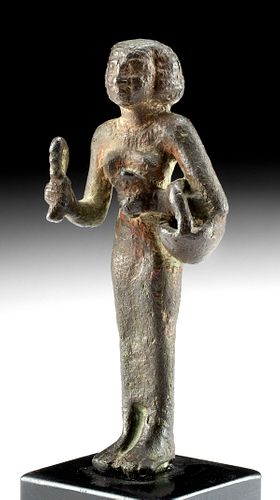Exhibited Egyptian Leaded Copper Priestess of Bastet
Lot 5
About Seller
Artemis Fine Arts
686 S Taylor Ave, Ste 106
Louisville, CO 80027
United States
Selling antiquities, ancient and ethnographic art online since 1993, Artemis Gallery specializes in Classical Antiquities (Egyptian, Greek, Roman, Near Eastern), Asian, Pre-Columbian, African / Tribal / Oceanographic art. Our extensive inventory includes pottery, stone, metal, wood, glass and textil...Read more
Categories
Estimate:
$10,000 - $15,000
Absentee vs Live bid
Two ways to bid:
- Leave a max absentee bid and the platform will bid on your behalf up to your maximum bid during the live auction.
- Bid live during the auction and your bids will be submitted real-time to the auctioneer.
Bid Increments
| Price | Bid Increment |
|---|---|
| $0 | $25 |
| $300 | $50 |
| $1,000 | $100 |
| $2,000 | $250 |
| $5,000 | $500 |
| $10,000 | $1,000 |
| $20,000 | $2,500 |
| $50,000 | $5,000 |
| $100,000 | $10,000 |
| $200,000 | $20,000 |
About Auction
By Artemis Fine Arts
Oct 8, 2020
Set Reminder
2020-10-08 10:00:00
2020-10-08 10:00:00
America/New_York
Bidsquare
Bidsquare : Exceptional Antiquities, Asian, Ethnographic
https://www.bidsquare.com/auctions/artemis-gallery/exceptional-antiquities-asian-ethnographic-5796
Museum-worthy examples of Egyptian, Greek, Roman, Etruscan, Near Eastern, Far East / Asian, Pre-Columbian, African / Tribal,Oceanic, Native American, Spanish Colonial, Russian, Fossils, Ancient Jewelry, Fine Art, so much more! Artemis Fine Arts info@artemisfinearts.com
Museum-worthy examples of Egyptian, Greek, Roman, Etruscan, Near Eastern, Far East / Asian, Pre-Columbian, African / Tribal,Oceanic, Native American, Spanish Colonial, Russian, Fossils, Ancient Jewelry, Fine Art, so much more! Artemis Fine Arts info@artemisfinearts.com
- Lot Description
Ancient Egypt, Third Intermediate Period, 22nd Dynasty, ca. 943 to 720 BCE. A stunningly well-preserved female figure depicting a priestess of Bastet, the cat-headed goddess of joy and the moon. Cast from leaded bronze, the priestess presents standing with tightly spaced feet while wearing a form-fitting dress known as a kalasiris and holding a sistrum in her outstretched right hand. In her left hand she holds an aegis - a decorative pectoral amulet meant as a symbol of protection - and supports the handle of a basket with her forearm. Her rounded face showcases puffy cheeks and a broad nose beneath almond-shaped eyes, and her corded coiffure is neatly arranged into several horizontal rows. Lustrous brown patina envelops the entire figure and creates a captivating Egyptian effigy. Size: 1.375" W x 3.7" H (3.5 cm x 9.4 cm); 4.9" H (12.4 cm) on included custom stand.
Bastet was initially a lioness goddess associated with the solar god and channeled its destructive powers. However, "With the Middle Kingdom the cat appeared as Bastet's sacred animal and after the New Kingdom she was depicted with a cat's head. The goddess' character became more and more friendly. She was connected with the moon . . . [and] The 'raging' aspect of earlier times was transferred to the goddess Sekhmet, who thereby became the negative, destructive side of Bastet." (Lurker, Manfred. "The Gods and Symbols of Ancient Egypt." Thames and Hudson, London, 1986, p. 32) Ever since, statuettes comprised of various materials have characterized her as a doting mother cat. Her cult expanded decisively when her town of Bubastis (derived from Per Bastet, meaning "House of Bastet") became the royal residence of the kings of the 22nd Dynasty during the 10th century BCE. The city hosted an annual festival honoring Bastet in celebration of the Nile flood waters, and she was honored throughout Egypt through the first millennium BCE.
Beyond the goddess, cats - known in ancient Egypt as "mau" - were honored and protected in Egyptian society. Herodotus famously wrote that Egyptian men would protect cats from fire and that households would mourn the death of a cat and by shaving their eyebrows to signify their loss. A bronze votive like this example was perhaps sold at a temple in Bubastis to a worshipper and either given as an offering or kept in a personal shrine or altar. The quality of this votive suggests that it was a rich and potent offering.
Published in J. Eisenberg, "Art of the Ancient World: The Age of Cleopatra." (1988), no. 55; J. Eisenberg, "Art of the Ancient World." (2018), vol. XXIX, p. 75, no. 152
On loan to Picker Art Gallery, Colgate University and Fitchburg Art Museum from 1990 to 2016.
Cf. an example from the Late Dynastic Period at The Brooklyn Museum of Art, accession number 37.402E.
Provenance: private Tecumseh, Michigan, USA collection, acquired in January 1989; ex-Royal-Athena Galleries, New York, New York, USA; ex-private French collection; on loan to Picker Art Gallery, Colgate University and Fitchburg Art Museum from 1990 to 2016
All items legal to buy/sell under U.S. Statute covering cultural patrimony Code 2600, CHAPTER 14, and are guaranteed to be as described or your money back.
A Certificate of Authenticity will accompany all winning bids.
We ship worldwide and handle all shipping in-house for your convenience.
#158237Very light abrasions and encrustations, with minor softening to some facial details, otherwise intact and near-choice. Wonderful patina and preservation throughout.Condition
- Shipping Info
-
All shipping is handled in-house for your convenience. Your invoice from Artemis Gallery will include shipping calculation instructions. If in doubt, please inquire BEFORE bidding for estimated shipping costs for individual items.
-
- Buyer's Premium



 EUR
EUR CAD
CAD AUD
AUD GBP
GBP MXN
MXN HKD
HKD CNY
CNY MYR
MYR SEK
SEK SGD
SGD CHF
CHF THB
THB














